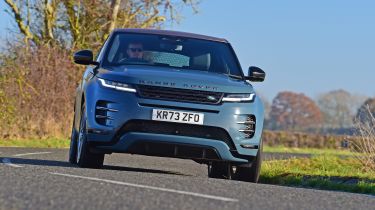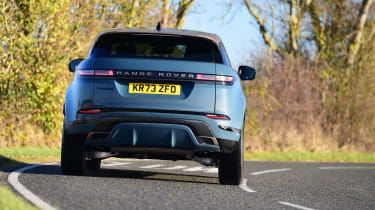Range Rover Evoque review - Engines, drive & performance
Rivals may be better to drive, but the Evoque is an excellent long-distance cruiser
The Range Rover Evoque shares its underpinnings with the Jaguar E-Pace but the two aren’t the same to drive. As Jaguar is the JLR group’s sporty brand, the E-Pace is the better choice for keen drivers as it’s sharper, firmer and more involving to drive. With the new Evoque, Land Rover has focused on comfort and refinement to avoid being too similar to the E-Pace, which does make it a distinguished cruiser.
Overall, it feels more grown-up than the previous generation. The steering is precise enough and there's ample grip, but also a noticeable amount of body roll in faster corners. The whole car feels happier at a relaxed pace, and driving fast down a twisty road will confuse the nine-speed automatic gearbox. Although a sporty Evoque would be missing the point slightly, it's not as good to drive as a BMW X1 and it does feel like Land Rover’s engineers could have made the Evoque better to drive if they weren’t concerned about it treading on the toes of the E-Pace.
Despite few Evoque owners ever taking their vehicle further than a wet field or a muddy car park, Land Rover committed to making the Evoque capable of taking on more challenging terrain. A wading depth of up to 600mm is beyond many competitors in this class, some of which don’t quote any wading depth at all. Land Rover’s Terrain Response 2 offers drivers a set-up for Comfort, Sand, Grass Gravel Snow, or Mud and Ruts, so you can keep going far from the city streets many buyers will actually use them on.
Range Rover Evoque diesel engines
A 2021 update introduced a revised diesel engine range for the Evoque consisting of a 2.0-litre diesel engine with two power outputs – 161bhp and 201bhp, badged as D165 and D200 respectively.
More reviews
The entry-level D165 is available with either a manual or automatic gearbox but the former is only offered with front-wheel drive. Automatic versions of the D165 come with four-wheel drive and mild-hybrid technology. The manual D165 manages 0-60mph in 9.5 seconds and the automatic does it in 9.2 seconds. We’d avoid the D165 if you can afford to, as it feels underpowered.
The D200 takes care of the 0-60mph sprint in 7.9 seconds, which is quick enough for a luxury small SUV. The diesel engines are very smooth and whisper quiet, even at motorway speeds. In the versions with mild-hybrid tech, the electric assistance helps reduce the diesel engine’s harshness above 2,500 rpm, keeping the cabin pretty peaceful.
When equipped with the D200 engine, the Evoque is never short of power, and it takes care of overtaking and towing duties with ease. It offers more than adequate performance, but is slightly let down by an automatic gearbox that struggles to decide which gear to select. It's fairly smooth, though, sitting between the Audi DSG and the smooth BMW eight-speed.
Petrol engines
While there used to be a range of petrol engines, the lineup has been heavily reduced as of mid 2024 to just one mild-hybrid 1.5-litre engine engine with 158bhp and front-wheel drive, badged P160. It’s sluggish from 0-62mph, completing the sprint in 9.7 seconds and onto a top speed of 124mph.
The discontinued models used a 2.0-litre petrol engine available in three power outputs – 197bhp (badged P200), 247bhp (P250) or 296bhp (P300). These manage the 0-60mph sprint in 8.0, 7.0 and 6.5 seconds respectively, so it’s a shame there’s no longer the option if you wanted a speedy Evoque. All were only available with all-wheel-drive and the nine-speed automatic gearbox.
Plug-in hybrid engines
The first plug-in hybrid engine for the Evoque was the P300e, which uses a 1.5-litre petrol and an electric motor with a total output of 304bhp, but it’s since been removed from the lineup and replaced with the P270e, which produces 269bhp. The P270e does the 0-62mph sprint in 6.8 seconds.
The discontinued P300e powertrain was the fastest accelerating Evoque you could buy, managing 0-60mph in 6.1 seconds, so again, it’s a shame it’s no longer available for those after something a little peppier.
Equally impressive is that when using electric power only, the P300e can reach speeds of up to 84mph. From a standing start the car emits a synthetic whooshing noise to warn nearby pedestrians but any drone from the electric motor itself is minimal thanks to its location on the rear axle and the car’s sound insulation. It’s comfortably powerful enough to get you moving around town as well, with a useful graphic in the digital instrument cluster keeping you updated as to how much battery charge you have remaining.
The switchable driving modes are straightforward to use, and are operated via a switch mounted on the centre console. Selecting hybrid mode combines both electric and petrol power, with EV allowing the car to run on battery power for as long as possible. The third, ‘Save’ mode, allows you to reserve the battery power for a particular part of a journey, but this does have an impact on fuel economy. During our test, we found that using Hybrid mode was most efficient, with the P300e capable of completing most short journeys using battery power alone, and even in cold weather, the 38-mile claim seems relatively easy to achieve. You’ll want to plug in as often as possible though, as economy barely scratches 30mpg with an empty battery.
Once the battery is depleted the engine automatically switches on, with the transition to petrol power smooth and barely noticeable. This helps make the plug-in hybrid Evoque very refined on the move, far more so than PHEV rivals such as the Volvo XC40 T5.
When you do require the petrol engine, its three-cylinder thrum only makes itself known at higher revs. The eight-speed automatic gearbox is well-matched to the PHEV powertrain, with smooth gear changes at all speeds. Despite the battery and electric motor increasing the car’s weight to two tonnes, it’s sure-footed when cornering. Body control is good and there’s a refined ride quality that hides minor road imperfections very well.










